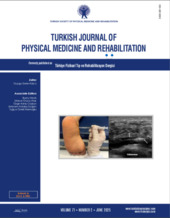Effects of acupuncture on oxidative stress mechanisms, pain, and quality of life in fibromyalgia: A prospective study from Türkiye
2 Department of Physical Medicine and Rehabilitation, Ankara Yıldırım Beyazıt University Faculty of Medicine, Ankara, Türkiye
3 Department of Medical Biochemistry, Karadeniz Ereğli State Hospital, Zonguldak, Türkiye
4 Department of Medical Biochemistry, Ankara Yıldırım Beyazıt University Faculty of Medicine, Ankara, Türkiye DOI : 10.5606/tftrd.2024.14372 Objectives: The aim of this study was to investigate the correlation between the use of real acupuncture and the quantities of intracellular oxidized, reduced, and total glutathione, as well as clinical indices including pain, depression, and quality of life in patients diagnosed with fibromyalgia syndrome (FMS).
Patients and methods: Between June 2019 and January 2020, a total of 52 female patients (mean age: 45.5±7.5 years; range, 30 to 56 years) who suffered from FMS and 26 healthy females (mean age: 44.2±6.8 years; range, 29 to 52 years) were included in a prospective manner. The patients were divided into two groups: those who received real acupuncture (n=26) and those who received sham acupuncture (n=25). The clinical features of the subjects were assessed at three time points: before therapy (T0), after the last session of treatment (T1), and one month following intervention (T2). The levels of intracellular oxidized, reduced, and total glutathione were assessed in whole sample at two time points, T0 and T2.
Results: At time T0, the quantity of intracellular oxidized, reduced, and total glutathione were higher in FMS patients than the control group, indicating higher levels of oxidative stress (p=0.001). In the group that received real acupuncture, there was a notable increase in the levels of intracellular oxidized, reduced, and total glutathione in T2 compared to T0. The difference in antioxidant activity was statistically significant (p=0.001). While comparing the percentage alterations in clinical variables and oxidative stress indicators between the real and sham groups at T0 and T2, the differences in the real acupuncture group were much higher (p=0.001).
Conclusion: Our study results indicate that real acupuncture may have an effect on the oxidative homeostasis in individuals with FMS.
Keywords : Acupuncture, fibromyalgia, glutathione, oxidative stress

















